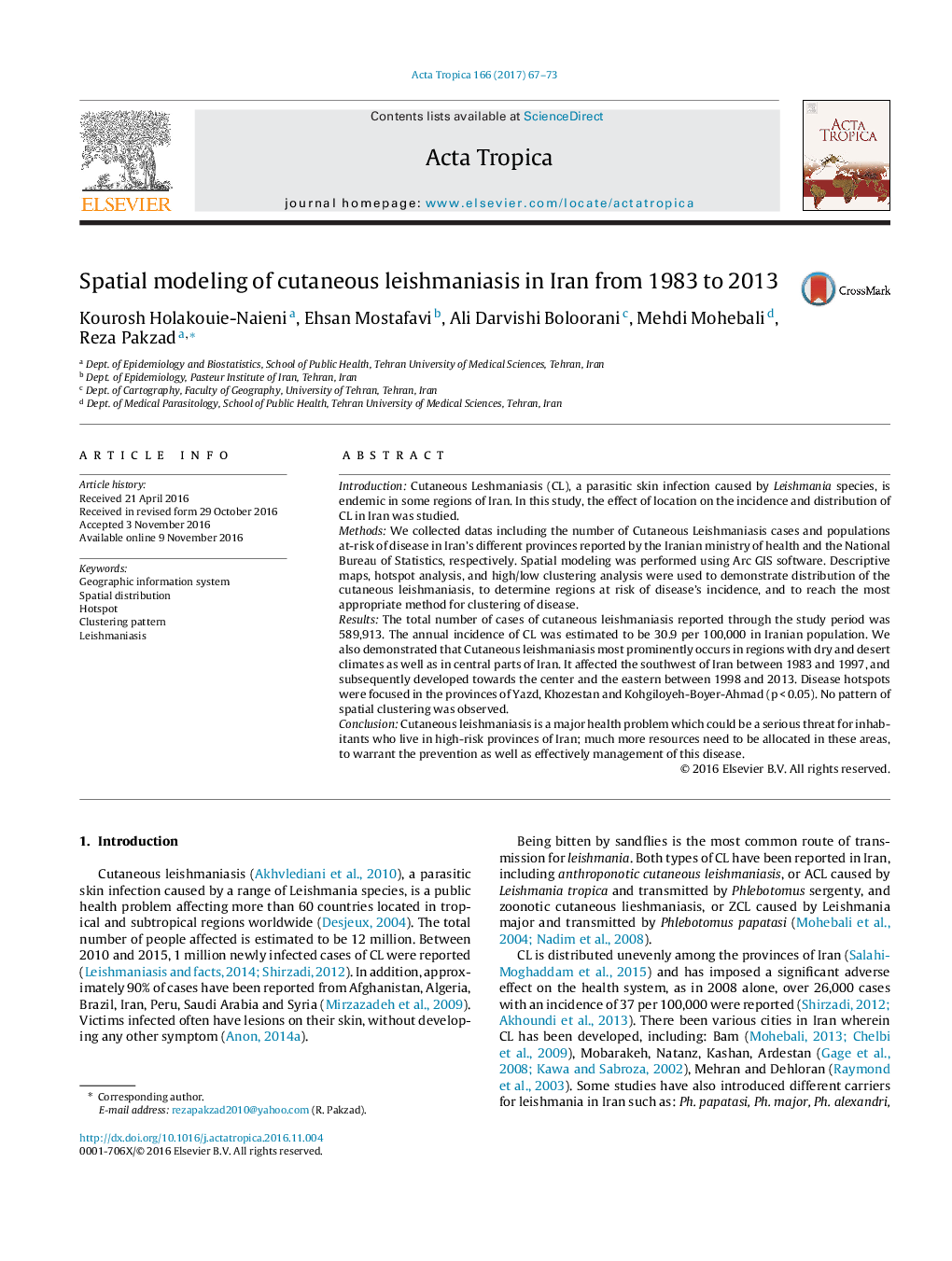| کد مقاله | کد نشریه | سال انتشار | مقاله انگلیسی | نسخه تمام متن |
|---|---|---|---|---|
| 5670891 | 1592758 | 2017 | 7 صفحه PDF | دانلود رایگان |
- The average annual reported incidence of the Cutaneous Leishmaniasis in the study period throughout the country was 30.9 per 100,000 people.
- The distribution of the Cutaneous Leishmaniasis was most prominent areas exhibiting dry and desert climate and in the central region of the country.
- This study showed that Cutaneous Leishmaniasis was concentrated in the southwest of Iran during between 1983 and 1997, and migrated towards the center and east of the country during the period 1998- 2013.
- Hot-Spots of Cutaneous Leishmaniasis were located in the provinces of Yazd, Khuzestan and Kohgiloyeh-Boyer- ahmad (p < 0.05). The northwest provinces were less affected.
- There was no pattern of spatial clustering of the Cutaneous Leishmaniasis.
IntroductionCutaneous Leshmaniasis (CL), a parasitic skin infection caused by Leishmania species, is endemic in some regions of Iran. In this study, the effect of location on the incidence and distribution of CL in Iran was studied.MethodsWe collected datas including the number of Cutaneous Leishmaniasis cases and populations at-risk of disease in Iran's different provinces reported by the Iranian ministry of health and the National Bureau of Statistics, respectively. Spatial modeling was performed using Arc GIS software. Descriptive maps, hotspot analysis, and high/low clustering analysis were used to demonstrate distribution of the cutaneous leishmaniasis, to determine regions at risk of disease's incidence, and to reach the most appropriate method for clustering of disease.ResultsThe total number of cases of cutaneous leishmaniasis reported through the study period was 589,913. The annual incidence of CL was estimated to be 30.9 per 100,000 in Iranian population. We also demonstrated that Cutaneous leishmaniasis most prominently occurs in regions with dry and desert climates as well as in central parts of Iran. It affected the southwest of Iran between 1983 and 1997, and subsequently developed towards the center and the eastern between 1998 and 2013. Disease hotspots were focused in the provinces of Yazd, Khozestan and Kohgiloyeh-Boyer-Ahmad (p < 0.05). No pattern of spatial clustering was observed.ConclusionCutaneous leishmaniasis is a major health problem which could be a serious threat for inhabitants who live in high-risk provinces of Iran; much more resources need to be allocated in these areas, to warrant the prevention as well as effectively management of this disease.
122Hot-Spots for Cutaneous Leishmaniasis were mostly observed in areas exhibiting dry and desert climates, concentrated in the southwest of Iran from 1983 to 1997, migrating to the center and east of the country in the period 1998-2013. The hotspot map showed disease foci in the provinces of Yazd, Khuzestan and Kohgiloyeh-Boyer-Ahmad (p < 0.05). The Northwest provinces are low- risk region for Cutaneous Leishmaniasis.
Journal: Acta Tropica - Volume 166, February 2017, Pages 67-73
